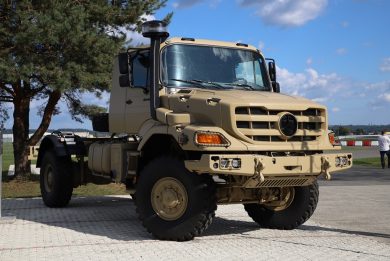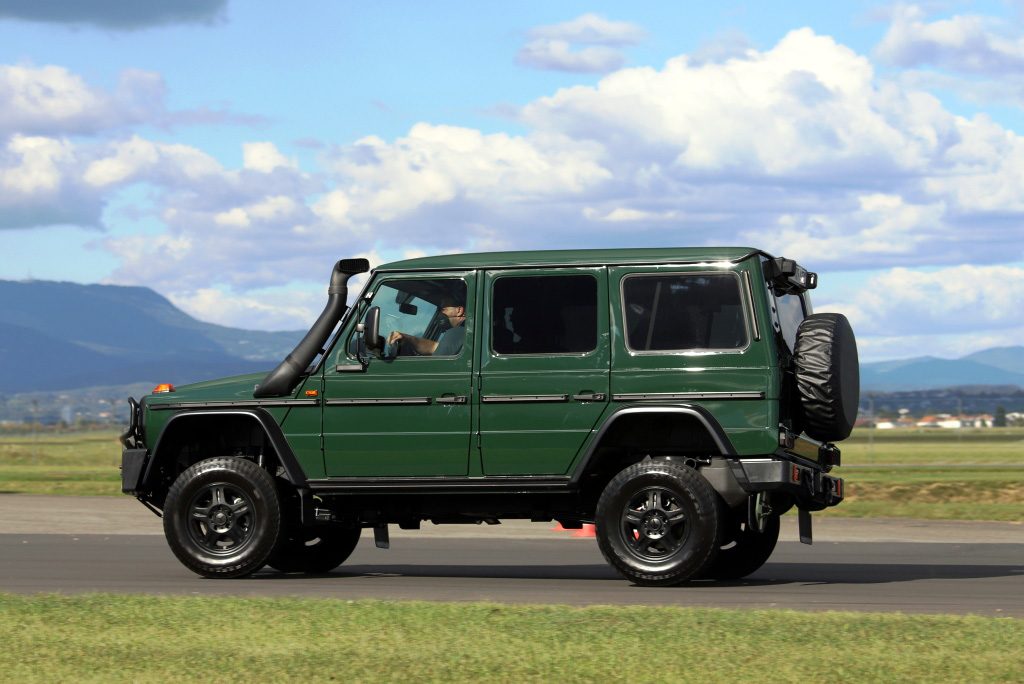
Mercedes-Benz: a new G-Class after 42 years of history
Next year will mark the 50th anniversary of the very beginning of the G-Class story: it was in 1972 that Daimler-Benz AG and Steyr-Daimler-Puch AG started cooperating on the development of a vehicle capable to answer the needs of on- and off-road mobility, in the most challenging conditions, aiming both at private individuals and at state customers. In that time one of the Daimler-Benz main shareholders was Mohammad Reza Pahlavi, the Shah of Iran; it was him that suggested the development of such a vehicle, the Iranian Army needing a similar system. Known as Geländewagen, the prototypes of the G-Model series 460 were produced in Graz, Austria, and presented in 1979, the same year that saw the Shah of Iran overthrown from his ruling position, which led to the cancellation of the order for 20,000 vehicles filed by Iran.
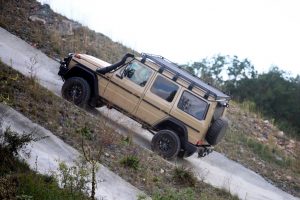
The link between the G-Model and the capital of Styria remained solid in the following decades, the vehicle being produced there. Overall more that 400,000 vehicles exited the assembly line in the last 42 years, and it is here that on September 28th Mercedes-Benz unveiled the latest version of what is now the new G-Class, the BR464, which was presented at the G-Class Experience Centre in Graz in the “Rescue and Special Operations[1]” militarised variant, aimed at governmental customers, which differs in many details from that aimed at the commercial market.
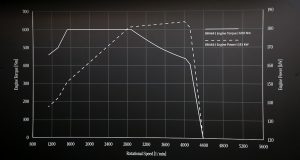
The new vehicle is fitted with a Euro 3, 3-liter Mercedes-Benz OM656 6-cylinder in-line turbodiesel engine rated at 183 kW (249 hp), which provides a 600 Nm torque. This means an increase of 35% in available power and 50% in torque compared to the previous 461 model, another improvement being fuel consumption, which is reduced by 6-8% depending on mission profile. The engine is linked to a Mercedes-Benz 9G-Tronic gearbox, which in first gear and low range allows a crawl speed between 2 and 14 km/h. All this considerably improves the mobility, as the Gross Vehicle Weight (GVW) of the BA06 base model (officially the Station Wagon 4×4 BA06 G 350 d) fitted with the full-length four passengers cabin remained nearly the same of the previous model, that is 3.5 tonnes. The new Euro 3 engine gives a power-to-weight ratio of over 71 hp/t, an increase in line with that of the engine output; the choice of the Euro 3 engine is due to its flexibility in terms of fuel, the OM656 being able to run permanently also with diesel fuel containing 500 parts per million (ppm) of sulphur, but can also run for 400 hours with 3,000 ppm fuel, making it quite flexible when used in some geographic areas where finding European standard diesel fuel might prove impossible. The BR464 BA06 has a 2,850 mm wheelbase, total length being 4,780 mm, width being 1,999 mm (rearview mirrors included) and height at rooftop 2,097.5 mm, with a 221 mm ground clearance. It adopts a new suspensions set-up, and is fitted with 265/70 R16 tires. The lower consumption allows increasing the range keeping the 80 litres fuel tank, a 96 litres tank being available as option should the customer need an even longer range.
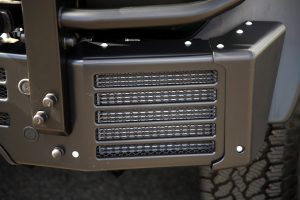
The BR464 cooling system has been optimised, and an external oil cooler has been installed, hosted in the left side of the front bumper, the latter being one of the most distinctive features of the new vehicle, which shape remains however very similar to what has become a sort of brand in itself. The front of the vehicle has also evolved to cope with increased cooling needs of the new engine. The air intake is on the left and has been raised, the filter ensuring that clean air is collected. When the vehicle is called to perform in specific areas, such as the desert, a cyclone filter is available as option.
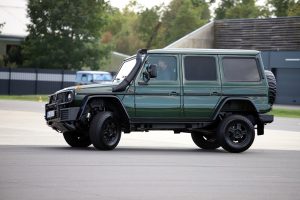
Answering a customers’ request that emerged at the 2017 G-Class users meeting, the electric system has been considerably improved; three batteries are now installed. The standard 12 V alternator is linked to the 92 Ah 12 V battery located at the rear of the vehicle, while a 24 V 3,840 W alternator works with the two batteries fitted in the engine compartment, that provide electric power to subsystems installed on the vehicle, the 24 V power grid being therefore separated form the 12 V one. Additional sockets inside and outside the vehicle can be installed at customers’ will.
Another request coming from governmental customers was to have new seats, capable to host a person wearing a body armour; seats have therefore be redesigned, which can withstand up to 120 kg, while the wheel is now fully adjustable to cope with drivers wearing a ballistic vest, steering being also more comfortable. The internal layout has also been optimised, standardising and strengthening the fixing points that would host subsystems installed by customers.
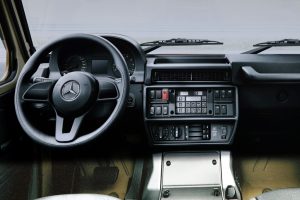
© Mercedes-Benz
The cockpit is splash proof and has been purposely designed to allow all switches and commands to be operated with gloves. An Emergency Override Switch, protected by a red cap similar to that of weapons release, allows to deactivate the anti-boil protection, to start the engine even when some sensors are defective, to drive despite defective accelerator pedal or wiring, and to bypass error messages from temperature sensors. This allows the driver to get out from dangerous situations overriding the protection systems should the vehicle show some problem.
An electromagnetic compatibility package ensures the BR464 compliance with civilian as well as with military ECM standards, avoiding any interference with communications equipment.

The new BA06 can reach 160 km/h on road, can climb 100% ramp, travel on a 54% side slope, approach and departure angles being very similar, respectively 35° and 36° (compared to the 30° of the previous models), the ramp angle being 22°. The vehicle is able to ford a 660 mm water obstacle in fresh water (versus 600 mm), special provisions being required should a customer want it to operate in salt water conditions. The BR464 can operate up to 50°C and down to –35°C, and at altitudes up to 4,000 meters.
Coming to payload, the BR464 BA06 has roughly the same payload of its predecessor, 1 tonne, however we must consider that improvements took their toll in terms of weight increase, hence the designers had to carry out a weight reduction operation on the structure and other elements to bring back the curb weight in the same region of that of the BR461, as the GVW of the two vehicles is very similar. All in all, around 50% of the components of the BR464 are entirely new or have been strengthened,

Until now we focused mostly on the BA06, the full-length cabin version. The BA09 (officially the Chassis Cab 4×4 BA09 G 350 d) is a longer wheelbase version, 3,650 mm, which is 5,397 mm long, 2,514 mm wide (rearview mirrors included) and 2,107.5 mm high at rooftop, with a 221 mm ground clearance. The curb weight is marginally lower than that of the BA06, as it is fitted with a short cabin hosting two passengers. Most of the weight saving is spent in the lengthening and strengthening of the chassis, suspensions being also improved as this version has a 2.5 tonnes payload with a 4.9 tonnes GVW, which means the payload is more than half the gross weight. It maintains all the peculiarities of the BR464 model, the power-to-weight ration being here of over 50 hp/t, well sufficient to ensure optimal mobility on road, the maximum speed is 120 km/h, as well as off-road, its role being obviously different from that of the BA06, the BA09 being ready to be fitted i.e. as ambulance, command post or shelter transport.
During the initial briefing both the BA06 and BA09 rolled on stage carrying the presenters who took the floor from Dr. Emmerich Schiller, the Head of Mercedes-Benz G-Class, in sequence Nils Buettner, the Product Manager G-Class for Rescue and Special Operations, and Dr. Ralf Ackermann, the Head of Engineering.
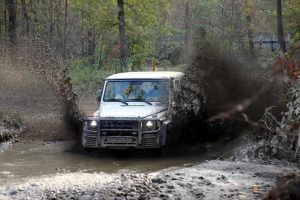
The trials were however carried out only with BA06 vehicles, probably as most of the 64 prototypes built were in that configuration. These were submitted to a complete series of tests, including cold and hot weather, some of them operated in Morocco for two weeks prior the presentation, and overall over 500,000 km were covered. Speed, stability, earth and stone ramps, side slope, fording, were the tests that EDR On-Line could witness both from outside and onboard the vehicles, the last one being the 100% metal ramp. At the beginning of the forest test track, which included fording, the 9th serial vehicle produced in Graz 42 years ago was looking at its successors logging their first “official” kilometres.

click on image to enlarge
In the first half of next year Mercedes-Benz will discontinue the BR461 assembly line, the first BR464 serial vehicles being due to roll-out from the line in mid 2022. The company will ensure full logistic support to the previous model for the next 15 years. As for the new vehicle, some LRIP (Low Rate Initial Production) vehicles are already being assembled for early customers, on which the company declined to comment.
The launch of the new G-Class BR464 comes at a key moment for the company, as what is currently known as Daimler AG will soon see its activities split, as it will give birth to Daimler Truck Holding AG and Mercedes-Benz Group AG, focused respectively on trucks and cars. As for Mercedes-Benz G-Class a solution will be found in order to satisfy both commercial and design and production issues.
Looking into the future, armoured derivatives will certainly become part of the portfolio, however Mercedes-Benz is considering cooperation with companies specialised in the armour field, and a first example of such cooperation was visible at the static display, dubbed LAPV464, for Light Armoured Protected Vehicle. Technology insertions might also give birth at new versions: for the time being a hybrid version of the G-Class BR464 is not foreseen, however the technology is there, some trucks already running on hybrid or even all-electric powerpacks. Seeing a hybrid G-Class BR464 is thus more a question of market than technical issues.
Photos © P. Valpolini
[1] From here on all data refer to the Rescue and Special Operations version



